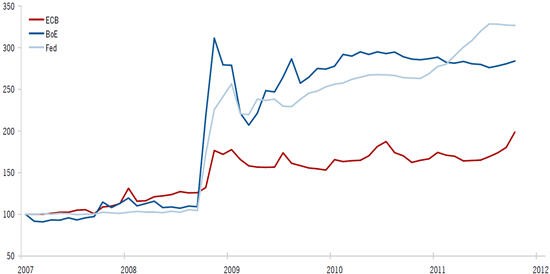Overview of the commodity market Perspectives Pictet
Post on: 16 Март, 2015 No Comment

By Perspectives Pictet Published: Wednesday February 06 2013
In this article taken from the latest Pictet Report. Financial Times commodities editor Javier Blas explains that commodity trading houses have become powerful and diversified businesses operating across the supply chain—and courting outside investors.
Investors all over the world are turning to commodities to diversify their portfolios and hedge against rising inflation. Commodities have come into their own as an asset class, with more than USD400 billion of assets under management, compared with just USD10 billion in 2000. This surge of capital into the industry has come at a time when commodity trading houses have been transforming themselves in ways that demand much greater investment.
One aspect of the transformation of the commodity trading houses is the trend towards consolidation. Twenty years ago, there were typically 15–20 traders in each commodity, whereas today there are around 15 large houses globally trading across a range of commodities. They have thus become much more powerful, but they have also diversified: a company might trade crude oil, petroleum, gas, corn, coffee, zinc, coal and perhaps even iron ore.
Javier Blas
Commodities editor
Financial Times
The largest, such as Glencore, trade everything from metals and oil to wheat and sugar. A second big trend is the expansion of trading houses across the commodities supply chain. In the 1970s they were just middlemen, buying from producers to sell to users for a slightly higher price. So a back-to-back deal might involve buying copper from a Chilean miner who has no contact with potential customers and selling it to a Japanese smelter which lacks the expertise to source copper at the best price. In the 1980s, however, traders increasingly began using their knowledge of commodity markets to do arbitrage deals. For example, they might buy commodities in one country to sell in another where prices were higher, or buy at times when demand was lower to sell at times when it was higher. This produced higher profits than simple back-to-back deals, but as the practice became widespread, profitability declined.
The latest phase is vertical integration, as trading houses move into other parts of the supply chain such as production, refining, processing, logistics and storage. By becoming involved in farming, oilfields, mines, ports, shipping, refining and smelting, they can increase their profits. That is why Glencore bid for the mining group Xstrata, but other examples include the purchase of Shell’s petrol station network in Africa by Vitol, an energy trading company. The oil-trading house Gunvor bought two refineries from Petroplus, the bankrupt Swiss refiner. When trading houses were just intermediaries, they did not need much equity—they borrowed from banks to fund their trades. An oil shipment from Saudi Arabia to South Korea might take 40 days and could be financed by letters of credit secured on the cargo. But a group investing in oil fields, mines and refineries will have to tie up many millions of dollars of capital for long periods—perhaps 20 or 30 years. That is why trading houses are now tapping the capital markets for the first time. Glencore, for example, raised equity in its 2011 initial public offering. Trafigura has tapped the bond markets, as did Louis Dreyfus Commodities with its first bond issue in 160 years. And others have spun off subsidiaries and brought in strategic partners: Vitol, for example, created VTTI to own its terminals, ports and tanking business and sold 50 per cent to MISC of Malaysia. Trafigura is planning to list Puma, its subsidiary which operates downstream operations such as terminals, tanking and petrol stations. And Mercuria, an oil trader, has sold 50 per cent of its terminals and storage subsidiary to Sinopec of China.
The funding needs of trading houses have been further increased by rising commodity prices. When oil was USD25 a barrel ten years ago, a shipment of 1 million barrels required USD25 million in finance, which could be funded with letters of credit. When oil reached almost USD150 a barrel in 2008, that delivery would have needed nearly USD150 million of finance—at a time when the world’s financial system was crashing.
A trading house that used to need credit lines of USD2 billion to finance its business might now require USD20 billion. But the biggest providers of finance for commodities trading — BNP, Crédit Agricole, ING and Société Générale — are all shrinking their balance sheets after the financial crisis. Recent figures from the Bank of Canada show that the proportion of trading houses’ finance supplied by the European banks has fallen from 80 per cent two years ago to 50 per cent.
So traders are looking for new sources of finance. Other banks are coming into the market, using derivatives to hedge the value of the cargoes that provide the security. They include Citi and JP Morgan, as well as banks from Japan, the Middle East, Singapore and China.
Trading houses are also becoming very imaginative in raising funds. For example, they are securitising instruments such as letters of credit and selling them to investors such as pension funds in France and Germany. They are also turning to private equity firms and sovereign wealth funds, several of which have taken stakes in listed trading houses, bypassing the banks to tap investors directly.
To raise funds from investors, however, requires changes in the culture of the trading houses. Traditionally they have been very secretive—it was their intelligence about commodity market opportunities that made them more profitable. But today the world is flatter, and information is quickly disseminated through the digital media.
Arbitrage opportunities may last only a couple of days, not the months that they were profitable in earlier times. And outside investors inevitably demand more information about the company’s business and its prospects. Turning to outside investors has also made traders more aware of the importance of their public image. The oil for food scandal in Iraq and Trafigura’s export of oil waste to Ivory Coast were big hits to the firms’ reputations, and secrecy is no longer an option. Many traders are now embedding corporate social responsibility in their businesses, as well as tackling sustainability issues in the commodities supply chain.

At the same time as the sector is transforming itself, global commodity markets are also changing fast. Historically, trading was centred on Belgium and the Netherlands, in ports such as Antwerp, Rotterdam and Amsterdam. It later moved to London and New York, and on to Chicago which was close to many of the large US agribusinesses. After the Second World War, North American traders such as Cargill and Alcoa decided to start trading in Europe and found Switzerland the most attractive location. Neutral, it had an attractive tax regime and was a centre for the financial sector and the legal profession—both essential in commodities trading. It also had excellent telecommunications, unlike many other European countries at the time.
They were followed by cotton traders from Egypt after President Nasser came to power, and Russian traders after the fall of communism. European firms also arrived, attracted by the services and clusters of talent the country could offer.
Today Geneva, together with Zug and Lugano, is the leading European centre for trading oil, metals and agricultural commodities. But cities in other countries have also become centres, such as Houston in Texas after the deregulation of the US power and gas market in the 1980s. And increasingly Singapore is becoming a global centre in Asia because of its role as an entrepôt for the global oil industry.
Much of the growth and development of commodity trading since 2000 has been driven by the large increases in prices created by the industrialisation of China and other fast-growing economies in Asia and beyond. Demand has been high for every commodity, after a period when there had been insufficient investment on the supply side. When the price of oil headed towards USD150 a barrel as a result, it made investment in finding new sources attractive.
But this ‘supercycle’ is slowing as new supplies come on-stream. In this ‘less-super supercycle’, demand will remain strong and prices high—oil will not fall back to USD20 a barrel. But prices will not go on rising forever either: oil will not reach USD200 a barrel, but is likely to stabilise in a band of USD90–130.
Such stabilisation will put pressure on commodities producers as their costs continue to rise and margins are squeezed. Their employees can see what competitors in richer countries pay and are already demanding better conditions in countries such as South Africa. Governments will also want a piece of the action. That is why the share prices of mining and oil companies are under pressure.
Can the commodities sector keep pace with the continuing growth in world population? Prices will drift up with demand and that will bring new sources into production, such as shale gas and minerals deep under the ground or high in the mountains. While the supply of many commodities from the developed world may have peaked, there is great scope for production to rise in the emerging markets of Africa and Central Asia. There will often be political difficulties to overcome and infrastructure challenges such as power shortages and inadequate transport. But the rewards of opening up these new sources of commodities will be considerable and will help in overcoming such obstacles. The world’s population has grown from 2.5 billion in 1950 to around 7 billion today, and there is enough food, clothing and heating for everyone.
Many people still go hungry every day in Africa and South and South-East Asia, but this is a result of unequal wealth distribution and extreme poverty. As the world heads for 9 billion people by 2050, I am optimistic that the supply of commodities needed for everyday life will keep pace with the growth in global population.














